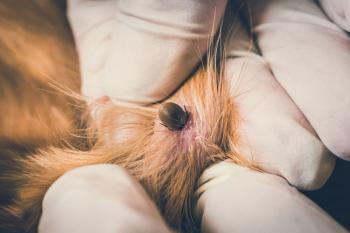
Achieving effective tick control (Proceedings)
In many areas of the US, tick populations are dense, and at certain times of the year and when climatic factors are ideal, tick activity may be very high, overwhelming the ability of an acaricide to control ticks on dogs.
Challenges in tick control
In many areas of the US, tick populations are dense, and at certain times of the year and when climatic factors are ideal, tick activity may be very high, overwhelming the ability of an acaricide to control ticks on dogs. With the exception of Rhipicephalus sanguineus, tick populations are maintained on wildlife and thus a constant source of re-infestation is provided to dogs from the environment. It is particularly challenging to protect dogs from ticks when the tick populations are allowed to persist in the area immediately surrounding the home. Controlling ticks on dogs thus requires strategies to also manage the habitat around the home that is serving as the source of ticks.
Such strategies include limiting exposure of dogs to tick infested areas by keeping them inside and preventing roaming; exclude wildlife from the area around the home with hard fencing; remove leaf litter and understory to minimize habitat for ticks; remove brush piles and other debris around the home where rodents may nest; install specific landscape features (e.g. gravel barrier between wooded area and yard) and keep grass and shrubs closely clipped to create tick-safe zones around the home where dogs and people spend their time. Acaricides may be judiciously applied to the wooded area immediately bordering the tick-safe zone, but broad-scale outdoor acaricide use alone in the absence of habitat management is rarely effective.
Home infestations with R. sanguineus present a unique challenge in tick control. By the time the home infestation is recognized, tick populations are very high and the infestation may take months to eradicate. Thorough cleaning of the home to remove environmental stages of ticks and debris where the ticks may hide can decrease populations. Acaricides must be applied to all dogs in the home. However, on-dog acaricide use alone is rarely effective at eliminating a home infestation and environmental application of acaricides is usually required. Contracting with a licensed pest control operator to spray acaricides safely and effectively in the home is strongly recommended.
Expectations for Success
Tick control products are labeled as effective using a model that employs a challenge dose of 50 ticks per dog. None of the available products claim 100% efficacy for the full 30-day period of activity; most range from 92-98% effective. During times of peak tick activity and in an ideal tick environment, dogs may encounter hundreds or even thousands of ticks on a single day. A product that is 95% effective would be expected to allow 5 ticks to feed out of every 100 encountered, and if 1000 ticks are encountered, the dog could acquire as many as 50 ticks. Accordingly, time of peak activity often result in apparent treatment failure. Other more common reasons for apparent product failure resemble those seen in flea control and include inconsistent use, inappropriate or incomplete application, and frequent bathing or swimming. In addition, clients may be more likely to recognize a low number of ticks attached to a dog, and thus concerned about efficacy, than they would a low number of fleas.
Strategies during overwhelming infestations
At times of overwhelming tick activity – or tick blooms – even dogs on regular monthly acaricides may become infested with ticks. Most acaricides dispensed by veterinarians are EPA-labeled products, and federal law prohibits application of those products more frequently than approved. It is critical, however, that acaricides be on the dogs prior to tick exposure. The level of acaricide on the animal progressively increases during the first 2-4 months of consistent use. Thus, application of a product should begin at least 3 months before the tick season is anticipated. Ideally acaricides will be applied to every dog all year long – less frequent or consistent use is associated with failure of control. During peak tick activity, products can be combined with one product applied the first of the month, a second the 15th of the month, and a third application (e.g. a collar) maintained throughout the month. By combining on-dog use of acaricides with management to reduce the level of tick exposure dogs encounter, infestations on dogs can be greatly reduced.
Selected references (additional references available upon request)
Cruthers, L, Slone, R, Arther, RG. K9 Advantix (imidacloprid plus permethrin) for controlling ticks and mosquitoes on dogs. Comp Cont Ed Prac Vet 2003; Supplement 25:(5A)15-18.
Dantas-Torres F. The brown dog tick, Rhipicephalus sanguineus (Latreille, 1806) (Acari: Ixodidae): from taxonomy to control. Vet Parasitol 2008;152(3-4):173-85.
Dryden M, Payne P, McBride A, Mailen S, Smith V, Carithers D. Efficacy of Fipronil (9.8% w/w) + (S)-Methoprene (8.8% w/w) and Imidacloprid (8.8% w/w) + Permethrin (44% w/w) against Dermacentor variabilis (American Dog Tick) on Dogs. Vet Therap. 2008; 9(1):15-25.
Estrada-Peña A, Rème C. Efficacy of a collar impregnated with amitraz and pyriproxyfen for prevention of experimental tick infestations by Rhipicephalus sanguineus, Ixodes ricinus, and Ixodes scapularis in dogs. J Am Vet Med Assoc 2005; 15; 226:221-224.
Hunter, JS. Efficacy of frontline spray and frontline Topspot. Comp Cont Ed Prac Vet 1997; Supplement 19:15-16.
Otranto D, Dantas-Torres F, Breitschwerdt EB. Managing canine vector-borne diseases of zoonotic concern: part one. Trends Parasitol. 2009; 25(4):157-63
Rugg D, Hair JA. Dose determination of a novel formulation of metaflumizone plus amitraz for control of cat fleas (Ctenocephalides felis felis) and brown dog ticks (Rhipicephalus sanguineus) on dogs. Vet Parasitol 2007; 150:203-208.
Newsletter
From exam room tips to practice management insights, get trusted veterinary news delivered straight to your inbox—subscribe to dvm360.




